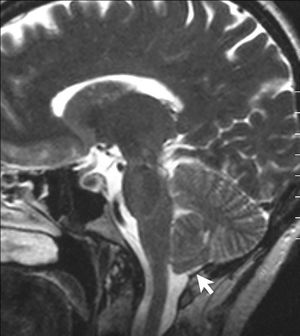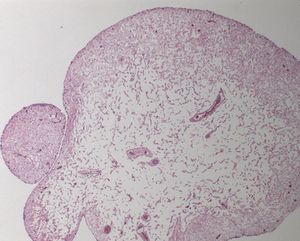Chiari malformation


A Chiari malformation (CM) or Arnold-Chiari malformation is a structural defect of the base of the skull and the cerebellum, characterized by a downward displacement of one or both cerebellar tonsils through the foramen magnum (the opening at the base of the skull), the lower part of the brain pushes down on the spinal canal.[3] This can sometimes lead to non-communicating hydrocephalus as a result of obstruction of cerebrospinal fluid (CSF) outflow.
The cerebrospinal fluid outflow is caused by phase difference in outflow and influx of blood in the vasculature of the brain.
Chiari malformation is usually congenital but can happen later in life – called secondary Chiari malformation – in the case of spinal fluid leak due to traumatic injury, disease, or infection.
Symptoms[edit | edit source]
There are four types of Chiari malformation with many symptoms, some that overlap and others that are unique to that type. The four types are diagnosed at different stages of life such as an ultrasound given during pregnancy, during an exam at birth or infancy, or in older children and adults.[3][4][5]
Chiari malformation can cause headaches, difficulty swallowing (sometimes accompanied by gagging), choking and vomiting, dizziness, nausea, neck pain, unsteady gait (problems with balance), poor hand coordination (fine motor skills), numbness and tingling of the hands and feet, light sensitivity and speech problems (such as hoarseness).[4][5]
Less often, people with Chiari malformation may experience ringing or buzzing in the ears (tinnitus), weakness, slow heart rhythm, or fast heart rhythm, curvature of the spine (scoliosis) related to spinal cord impairment, abnormal breathing, such as central sleep apnea, characterized by periods of breathing cessation during sleep, and, in severe cases, paralysis.[4][5]
Pathology[edit | edit source]
"The primary pathology in CMI is attributed to CSF flow obstruction, rather than the absolute location of tonsillar descent below the foramen magnum. The primary goal of surgery, therefore, is to restore normal CSF flow dynamics at the craniocervical junction, and hence, decrease the signs/symptoms attributed to CMI."[6]
Types[edit | edit source]
Chiari malformation Type I[edit | edit source]
In this type, the cerebellar tonsils extend into the foramen magnum. Normally, only the spinal cord passes through this opening. 30% of patients with Type 1 are asymptomatic. It is usually first noticed in adolescence or adulthood, often by accident during an examination for another condition. Adolescents and adults who no symptoms initially may develop signs of the disorder later in life.[5]
Chiari malformation Type II[edit | edit source]
Individuals with Type II have symptoms that are generally more severe than in Type 1 and usually appear during childhood. This disorder can cause life-threatening complications during infancy or early childhood, and treating it requires surgery.
In Type II, also called classic CM, both the cerebellum and brain stem tissue protrude into the foramen magnum. Also the nerve tissue that connects the two halves of the cerebellum may be missing or only partially formed. Type II is usually accompanied by a myelomeningocele—a form of spina bifida that occurs when the spinal canal and backbone do not close before birth. (Spina bifida is a disorder characterized by the incomplete development of the brain, spinal cord, and/or their protective covering.) A myelomeningocele usually results in partial or complete paralysis of the area below the spinal opening. The term Arnold-Chiari malformation (named after two pioneering researchers) is specific to Type II malformations.
Chiari malformation Type III[edit | edit source]
Type III is very rare and the most serious form of Chiari malformation. In Type III, some of the cerebellum and the brain stem stick out, or herniate, through an abnormal opening in the back of the skull. This can also include the membranes surrounding the brain or spinal cord.
The symptoms of Type III appear in infancy and can cause debilitating and life-threatening complications. Babies with Type III can have many of the same symptoms as those with Type II but can also have additional severe neurological defects such as mental and physical delays, and seizures.
Chiari malformation Type IV[edit | edit source]
Type IV involves an incomplete or underdeveloped cerebellum (a condition known as cerebellar hypoplasia). In this rare form of CM, the cerebellum is located in its normal position but parts of it are missing, and portions of the skull and spinal cord may be visible.
Diagnosis[edit | edit source]
Chiari I malformations are diagnosed using a T2-weight cranial or cervical MRI.[6] A cine-phase-constraint MRI is often used to assess whether the Chiari malformation is obstructing cerebrospinal fluid flow, viewed as a primary aspect of the pathology.[6]
Treatment[edit | edit source]
Treatment is posterior fossa decompression surgery.[6]
“Clinical improvement noted in the majority of patients treated surgically (83–100%), has been observed in conjunction with complication rates varying from 0 to 16.7%.”[6]
Co-morbidities[edit | edit source]
Common comorbidites of Chiari malformation include:
- Hydrocephalus[5] - an excessive buildup of cerebrospinal fluid in the brain. It can cause intracranial hypertension.
- Spina bifida[5] - an incomplete closing of the backbone and membranes around the spinal cord.
- Syringomyelia[5] -a disorder in which a cerebrospinal-filled cyst or syrinx forms within the spinal cord’s central canal.
- Tethered cord syndrome[5]
- Spinal curvature[5] - the spine either may bend to the left or right (scoliosis) or may bend forward (kyphosis).
- Craniocervical instability
Ehlers-Danlos syndrome[edit | edit source]
Misdiagnosis[edit | edit source]
Patients with Chiari I malformation may be misdiagnosed with migraine, multiple sclerosis, fibromyalgia, chronic fatigue syndrome or mental illnesses.[7][8]
Fibromyalgia[edit | edit source]
In the 1990s, there was a controversy surrounding whether Chiari malformation could cause the symptoms of fibromyalgia or chronic fatigue syndrome,[9][10] and some patients had unnecessary and potentially harmful surgery for Chiari I malformation in the hope of curing or improving ME/CFS or fibromyalgia, when their Chiara I malformation may have been asymptomatic or unsuitable for surgery, or the malformation did not meet the Chiari malformation criteria.[10][11]
There has also been discussion about whether Chiari I malformation was more or less common in fibromyalgia patients. A 2004 study of a non-random sample of 270 patients with fibromyalgia diagnoses found that 46% had cervical spinal stenosis and 20% chiari malformation.[12] However, a 2011 paper which compared a random sample of fibromyalgia patients to a control group failed to find any increased rate of Chiari malformation among people with fibromyalgia.[13] Chiari malformation is associated with Ehlers-Danlos syndrome,[14][15][16] which is sometimes misdiagnosed as fibromyalgia, or with which there may be diagnostic overlap.[17][18] In 2018, an American chart review of patients undergoing surgery for Chiari I malformation found that 14% had fibromyalgia and 14% had chronic fatigue syndrome, although it did not report how many patients had both fibromyalgia and CFS.[19]
ME/CFS[edit | edit source]
A Swedish study of 234 ME/CFS patients meeting the Canadian Consensus Criteria found that a substantial proportion of patients had signs on their brain MRIs suggestive of intracranial hypertension: 55% had increased diameter of the optic nerve sheath. In addition 80% had cerebellar tonsillar descent that could potentially cause disruptions to spinal fluid flow, and thus increased intracranial pressure. 13.2% had tonsillar herniations severe enough to be considered a Chiari Malformation.[20] In 2018, an American chart review of patients undergoing surgery for Chiari I malformation found that 14% had chronic fatigue syndrome.[19]
See also[edit | edit source]
Learn more[edit | edit source]
- Chiari Malformation - National Health Service
References[edit | edit source]
- ↑ Sekula, Raymond F; Jannetta, Peter J; Casey, Kenneth F; Marchan, Edward M; Sekula, L Kathleen; McCrady, ChristineS (2005). "Dimensions of the posterior fossa in patients symptomatic for Chiari I malformation but without cerebellar tonsillar descent". Cerebrospinal Fluid Research. 2 (1): 11. doi:10.1186/1743-8454-2-11. ISSN 1743-8454. PMID 16359556.
- ↑ Jensflorian (September 16, 2015). "Histology specimen of enlaged, dysplastic / reactive fibrous tissue and choroid plexus in a Chiari II malformation". commons.wikimiedia.org.
- ↑ 3.0 3.1 "Chiari malformation". National Health Service. October 18, 2017. Retrieved December 27, 2021.
- ↑ 4.0 4.1 4.2 "Chiari malformation - Symptoms and causes". Mayo Clinic. Retrieved September 2, 2018.
- ↑ 5.0 5.1 5.2 5.3 5.4 5.5 5.6 5.7 5.8 "Chiari Malformation Fact Sheet". National Institute of Neurological Disorders and Stroke. Retrieved September 2, 2018.
- ↑ 6.0 6.1 6.2 6.3 6.4 Baisden, Jamie (July 17, 2012). "Controversies in Chiari I malformations". Surgical Neurology International. 3 (Suppl 3): S232–S237. doi:10.4103/2152-7806.98580. ISSN 2229-5097. PMC 3422094. PMID 22905329.
- ↑ https://pubmed.ncbi.nlm.nih.gov/10232534/
- ↑ https://onlinelibrary.wiley.com/doi/abs/10.1111/j.1745-7599.2001.tb00239.x?sid=nlm%3Apubmed
- ↑ Burton, Thomas M. "Some Doctors Operate on People Diagnosed With Chronic Fatigue". Wall Street Journal. Retrieved July 7, 2019.
- ↑ 10.0 10.1 "CFS/FM and Chiari Malformation Surgery". Massachusetts ME/CFS & FM Association. Retrieved July 7, 2019.
- ↑ https://doi.org/10.1002/1529-0131(199912)42:12%3C2731::AID-ANR36%3E3.0.CO;2-K
- ↑ Heffez, Dan S.; Ross, Ruth E.; Shade-Zeldow, Yvonne; Kostas, Konstantinos; Shah, Sagar; Gottschalk, Robert; Elias, Dean A.; Shepard, Alan; Leurgans, Sue E. (April 9, 2004). "Clinical evidence for cervical myelopathy due to Chiari malformation and spinal stenosis in a non-randomized group of patients with the diagnosis of fibromyalgia". European Spine Journal. 13 (6): 516–523. doi:10.1007/s00586-004-0672-x. ISSN 0940-6719. PMC 3476600. PMID 15083352.
- ↑ Ellenbogen, Richard G.; Guan, Qingyan; Noonan, Carolyn; Maravilla, Kenneth R.; Goldberg, Jack; Buchwald, Dedra; Watson, Nathaniel F. (February 1, 2011). "Is Chiari I Malformation Associated With Fibromyalgia?". Neurosurgery. 68 (2): 443–449. doi:10.1227/NEU.0b013e3182039a31. ISSN 0148-396X.
- ↑ Castori, Marco; Camerota, Filippo; Celletti, Claudia; Danese, Chiara; Santilli, Valter; Saraceni, Vincenzo Maria; Grammatico, Paola (2010). "Natural history and manifestations of the hypermobility type Ehlers–Danlos syndrome: A pilot study on 21 patients". American Journal of Medical Genetics Part A. 152A (3): 556–564. doi:10.1002/ajmg.a.33231. ISSN 1552-4833.
- ↑ Francomano, Clair A.; McDonnell, Nazli B.; Nishikawa, Misao; Bolognese, Paolo A.; Milhorat, Thomas H. (December 1, 2007). "Syndrome of occipitoatlantoaxial hypermobility, cranial settling, and Chiari malformation Type I in patients with hereditary disorders of connective tissue". Journal of Neurosurgery: Spine. 7 (6): 601–609. doi:10.3171/SPI-07/12/601.
- ↑ Henderson, Fraser C.; Austin, Claudiu; Benzel, Edward; Bolognese, Paolo; Ellenbogen, Richard; Francomano, Clair A.; Ireton, Candace; Klinge, Petra; Koby, Myles (2017). "Neurological and spinal manifestations of the Ehlers–Danlos syndromes". American Journal of Medical Genetics Part C: Seminars in Medical Genetics. 175 (1): 195–211. doi:10.1002/ajmg.c.31549. ISSN 1552-4876.
- ↑ Rombaut, Lies; Malfait, Fransiska; Paepe, Anne De; Rimbaut, Steven; Verbruggen, Gust; Wandele, Inge De; Calders, Patrick (2011). "Impairment and impact of pain in female patients with Ehlers-Danlos syndrome: A comparative study with fibromyalgia and rheumatoid arthritis". Arthritis & Rheumatism. 63 (7): 1979–1987. doi:10.1002/art.30337. ISSN 1529-0131.
- ↑ Miller, Victor J.; Zeltser, Rephael; Yoeli, Zvi; Bodner, Lipa (July 1, 1997). "Ehlers-Danlos Syndrome, Fibromyalgia and Temporomandibular Disorder: Report of an Unusual Combination". CRANIO®. 15 (3): 267–269. doi:10.1080/08869634.1997.11746020. ISSN 0886-9634.
- ↑ 19.0 19.1 Houston, James R.; Eppelheimer, Maggie S.; Pahlavian, Soroush Heidari; Biswas, Dipankar; Urbizu, Aintzane; Martin, Bryn A.; Bapuraj, Jayapalli Rajiv; Luciano, Mark; Allen, Philip A.; Loth, Francis (February 1, 2018). "A morphometric assessment of type I Chiari malformation above the McRae line: A retrospective case-control study in 302 adult female subjects" (PDF). Journal of Neuroradiology. 45 (1): 23–31. doi:10.1016/j.neurad.2017.06.006. ISSN 0150-9861.
- ↑ Bragée, Björn; Michos, Anastasios; Drum, Brandon; Fahlgren, Mikael; Szulkin, Robert; Bertilson, Bo C. (2020). "Signs of Intracranial Hypertension, Hypermobility, and Craniocervical Obstructions in Patients With Myalgic Encephalomyelitis/Chronic Fatigue Syndrome". Frontiers in Neurology. 11: 828. doi:10.3389/fneur.2020.00828. ISSN 1664-2295.

